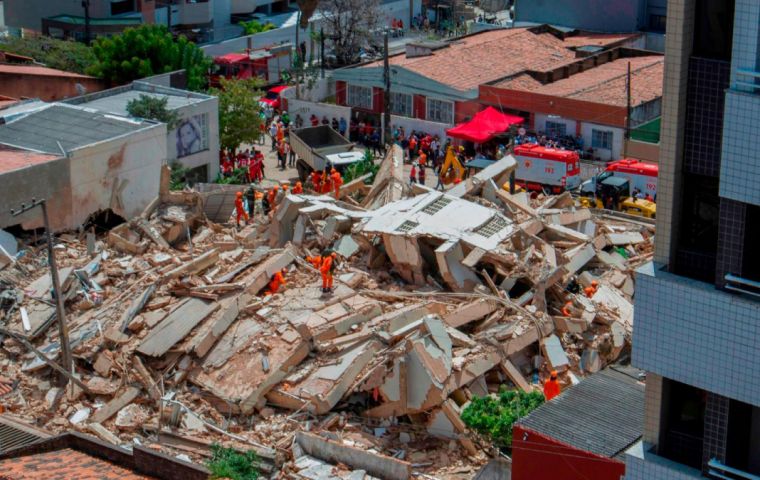MercoPress. South Atlantic News Agency
Housing disaster in Brazil: seven-story building collapses in Fortaleza
 The building in the northeastern city of Fortaleza collapsed without warning at about 10:30 a.m., cloaking the surrounding neighborhood in smoke and debris
The building in the northeastern city of Fortaleza collapsed without warning at about 10:30 a.m., cloaking the surrounding neighborhood in smoke and debris A seven-story building collapsed in northeastern Brazil on Tuesday, killing at least one person, trapping others — and drawing new attention to the unsettling frequency with which buildings in Brazil suddenly fall.
The building in the northeastern city of Fortaleza collapsed without warning at about 10:30 a.m., cloaking the surrounding neighborhood in smoke and debris. Video of the scene showed chaos: people rushing past cars covered in dust to reach the destruction in an upscale part of town, less than two miles from the tourist destination of Iracema beach. Firefighters searched the rubble for survivors.
“For now we are trying to hear sounds that indicate where people are,” Fortaleza fire spokesman Romario Fernandes said. “There are several layers of debris.”
The cause of the collapse was unclear. But building residents reportedly had shared concerns on social media about a construction project that had exposed rebar in foundation pillars.
“They are breaking the whole concrete structure that surrounds the pillars,” one resident wrote in messages published by the Fortaleza newspaper Diario do Nordeste. “I’m getting very scared of that.”
The disaster revealed vulnerabilities in Brazil’s urban infrastructure, long bedeviled by structural hazards, lax oversight and occupation by squatters. Now as economic stagnation strangles the country and more structures fall into disrepair, such collapses have become a reoccurring problem.
Twenty-three people were killed in April when a building in a poor part of Rio de Janeiro collapsed after being soaked by days of rain.
Seven died in May 2018 when a Sao Paulo high-rise occupied by squatters caught fire and crumbled.
A few months later, in September, a fire raged through Rio’s 200-year-old national museum, destroying nearly the entire collection. A faulty air conditioner was blamed, but the building lacked fire doors, sprinklers or water hoses.
Seventeen people were killed in 2012 when three adjacent office buildings in Rio collapsed, one after another.
The challenge of solving the country’s infrastructure problem is immense: Just to maintain and modernize existing structures, the consulting firm Inter B concluded this year, Brazil would have to double its 2019 investment in infrastructure to nearly US$100 billion.
But since Brazil’s economy slowed to a standstill, public spending as a percentage of gross domestic product has shrunk to half what it once was.
“It is essential that public funds be restored so infrastructure investment can be sustainably restarted,” Inter B President Cláudio Frischtak wrote. Even private investment requires public planning, he said.
In an effort to strengthen the country’s infrastructure, President Jair Bolsonaro launched a plan recently to double private investment in the sector by 2022.
Brazil’s infrastructure woes have been aggravated by housing shortages in major cities. In Greater Sao Paulo, 1.2 million families live as squatters in abandoned buildings or makeshift houses or are homeless, according to the municipal housing secretary.
Housing rights activists often take over dilapidated buildings to pressure the government to provide affordable housing. More than 150 buildings in the city have been seized by squatters.
In Rio, mudslides routinely wipe out whole neighborhoods and kill dozens of people a year. In 2011, almost 1,000 people were buried in a mudslide outside the city.




Top Comments
Disclaimer & comment rulesCommenting for this story is now closed.
If you have a Facebook account, become a fan and comment on our Facebook Page!